The history of Japanese green tea originated in 805 when Buddhist monks Saicho and Kukai returned to Japan from traveling in China with young tea trees. But this is just the beginning of the story. Today, we’ll explore more of the history of this beverage and how it came to be.
Over the centuries, tea became deeply intertwined with Japanese culture, evolving from a ceremonial drink to a social staple. Its journey through history mirrors Japan’s political and cultural shifts, with tea becoming a symbol of status and sophistication during the Heian and Kamakura periods. As tea cultivation spread across Japan, it adapted to the country’s unique climate and soil conditions, leading to the development of distinct varieties of tea, each with its own flavor profiles and brewing techniques. This early cultivation was a crucial step in shaping what would become a revered tradition—one that would lead to Japan being a global leader in green tea production.
How Japanese Green Tea Came To Be
In the 12th century, tea seeds were again brought to Kyoto by the famous Zen priest Eisai.
Eisai penned one of the oldest books on specialty tea in 1211, a two-volume book inspired by his last visit to China.
In it, he describes the positive health effects tea can have on both the mind and body, focusing primarily on tea’s medicinal qualities in improving brain function, vitalizing the heart, and eliminating indigestion. He also goes more in-depth, describing the shapes of tea plants, the different tea flowers and leaves of each plant, and how to process the tea leaves for drinking.
An influential figure, Eisai, helped introduce tea consumption to the warrior class during the Heian Period. Then, as the warrior class gained political prominence, the custom of drinking tea became widespread around Japan. It even makes its way to Edo, the former name of the city of Tokyo.
Soon, green tea will become a staple beverage among the cultured people of Japan. Although only privileged individuals primarily enjoyed it, green tea production increased by the end of the 16th century and was available to all people in Japan. (Click here to learn more about Eisai.)
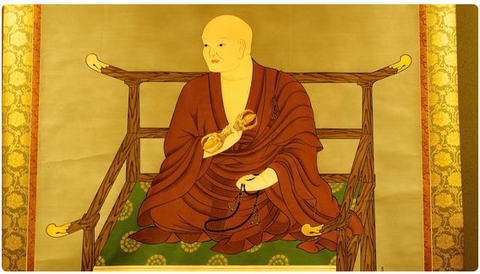
Picture of Kukai – Kukai brought back green tea from China in 805
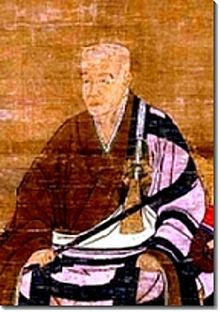 Picture of Eisai: Eisai penned one of the oldest books on specialty tea in 1211.
Picture of Eisai: Eisai penned one of the oldest books on specialty tea in 1211.
With the rise of the Ming Dynasty in the 14th century, Japan increased its cultural exchange with southern China. Among the merchandise being traded and passed overseas was green tea's roasting and processing methods.
Poetry, writing, paintings, and calligraphy depicting tea emerged during this time, eventually leading to the art of the tea ceremony.
This widespread interest in tea also prompted the establishment of tea houses, where people could enjoy the beverage in a peaceful setting, fostering connections and socializing. By the 15th century, the ceremonial preparation and consumption of tea had become a central part of Japanese culture, embodying Zen principles such as mindfulness and simplicity. It was during this time that the tea ceremony, or "chanoyu," took its formal shape, influencing not just how tea was consumed but how it was integrated into the cultural identity of Japan.
How Japanese Green Tea Evolved to a 250 Billion Yen Business
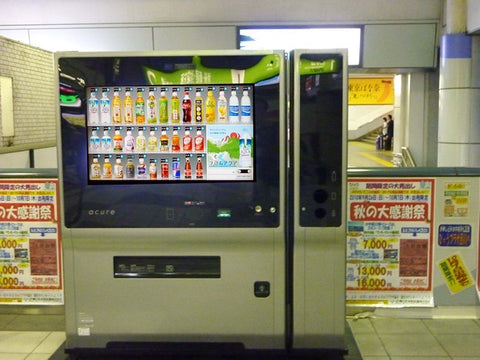
Green tea has since evolved into a billion-yen business over the past decade.
Ayataka, a brand of Coca-Cola in Japan that produces bottled green tea, has grown into a 777-billion-yen industry. Green tea is one of the most popular packaged beverages on the market in Japan.
Today, many Japanese people prefer their tea conveniently packaged in plastic bottles. Other companies are strong competitors to Coca-Cola in Japan’s tea-growing nation.
Japanese retailers generally only stock in-demand beverages, so the pressure to develop new green tea products and adaptations is high. Ito En, another of Japan’s traditional tea makers that produces bottled green tea in Japan, began adding powdered tea to their green tea drinks. This makes them cloudier and more indicative of richer-tasting teas traditionally brewed in a teapot.
In recent years, the green tea market in Japan has witnessed a shift toward innovation, with a growing focus on convenience and health benefits. Some companies have introduced ready-to-drink green tea options infused with additional vitamins and minerals, to cater to the health-conscious consumer. Furthermore, new product lines, such as sugar-free green tea and tea blends with flavors like citrus or ginger, have found their way into the market, expanding the appeal of green tea beyond traditional consumers. With an ever-expanding range of green tea-based products, including snacks, cosmetics, and even alcohol, the green tea industry has become a major player in Japan's broader food and beverage sector, contributing significantly to the country’s economy.
What is Green Tea?
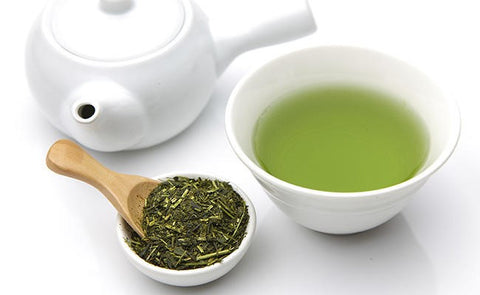
Green tea and black tea originate from the same species of Camellia sinensis. What differentiates green tea from black tea? How the tea leaves are processed gives them their unique taste and color.
There are two principal varieties of Camellia sinensis tea plants used when brewing tea.
Camellia sinensis, a smaller-leafed tea plant native to China, is primarily used for green and white teas. Camellia sinensis evolved as a shrub and grew in warmer regions with drier and cooler climates. This type of plant has a high tolerance for low temperatures and thrives well in mountainous areas.
To process the green tea, leaves are harvested from the tea plant and heated through steaming or pan-frying. Japanese green tea is steamed, whereas Chinese green tea is pan-fried.
Drying the leaves prevents oxidation and maintains their green color while locking in the fresh tea flavors. When green tea is brewed, the color is usually green, yellow, or very light brown. The flavors of the tea vary depending on whether the leaves are toasted through pan-frying, firing, or steaming. Pan-fried tea typically has a grass-like, vegetal flavor, while steamed leaves are sweeter and more seaweed-like.
Green tea’s distinct processing methods not only contribute to its flavor profile but also enhance its health benefits. Steamed green tea, common in Japan, retains more of its antioxidants compared to its pan-fried counterpart, making it a popular choice for those seeking a nutrient-rich beverage. The steaming process also preserves more of the natural enzymes in the tea, contributing to its fresh and delicate taste, which sets it apart from other teas.
What Type of Japanese Green Tea is Available?
There are many different green teas available, all originating from the same Camellia sinensis tea plant.
There are a few factors that differentiate these various types of green tea:
- Where the tea plants are grown
- How they’re cultivated
- The various climate conditions the plants endure
Many green teas originate from China.
Some notable types include:
- Gunpowder green tea and Dragonwell green tea, which are both grown in the Zhejiang Province of China,
- Snowy Mountain Jian, a green tea grown in the Yunnan Province of China
- Xin Yang Mao Jian, a unique tea grown in the Henan Province
Japan has a great variety of green teas, including Gyokuro, a green tea widely considered one of the best in Japan. Gyokuro tea is a shaded green tea grown in the shade rather than under the sun. Other varieties include Sencha green tea, the common "everyday" Japanese green tea.
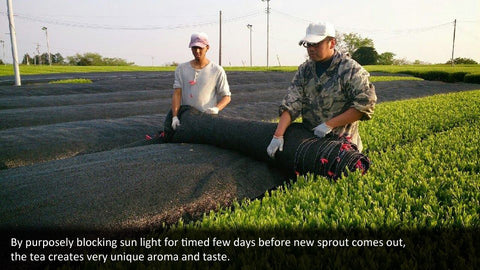
Although Gyokuro is a type of sencha tea, it has a unique cultivation method that originated in Japan. Before harvesting, Gyokuro tea leaves are kept out of the sun for at least two weeks. This causes the alkaloid caffeine and amino acid theanine in the leaves to increase, resulting in a sweeter tea flavor.
Although Gyokuro is a type of sencha tea, it has a unique cultivation method that originated in Japan. Before harvesting, Gyokuro tea leaves are kept out of the sun for at least two weeks. This causes the alkaloid caffeine and amino acid theanine in the leaves to increase, resulting in a sweeter tea flavor. Additionally, the shaded environment intensifies the tea’s green color and enhances the overall umami taste, making Gyokuro a premium choice for tea enthusiasts seeking a richer, more refined flavor profile. Other varieties, like Bancha and Hojicha, offer distinct flavors and are often consumed throughout the day as more affordable options.
Matcha Green Tea
The most notable form of green tea from Japan is matcha green tea, made from powdered gyokuro.
Matcha tea leaves are also grown in the shade. But unlike typical gyokuro leaves, they're not just steamed, dried, and rolled during the cultivation process.
Matcha leaves go through a unique refining phase where the leaves are cut, the stems and veins are removed, and just the meat of the leaves is left before they are dried out. The leaves are then called tencha and ground into a powder known as matcha.
Matcha green tea is widely known for being used in traditional Japanese tea ceremonies.
(Read my other popular article, 25 Matcha Trivia You (Probably) Didn't Know here.)

Health Benefits
Many consider green tea to be one of the healthiest beverages in the world.
It's loaded with antioxidants, such as polyphenols, L-theanine, catechins, and EGCG, as well as other powerful nutrients that can have incredibly positive effects on the body. Notably, these include lowering your risk of cancer. Drinking green tea can also speed up your metabolism, leading to weight loss and an overall decrease in body fat. Green tea also contains caffeine, which acts as a stimulant to improve brain function.
Although all types of green tea have their benefits, try to drink higher-quality brands of green tea. Some lower-quality brands may contain excessive fluoride levels, which can be dangerous when ingested in large quantities.
Furthermore, green tea’s health benefits extend to mental well-being, as the presence of L-theanine, an amino acid, can promote relaxation and reduce stress levels. This makes it an excellent choice for those looking to enhance focus and maintain mental clarity throughout the day. Studies have even suggested that regular green tea consumption may improve memory and cognitive function, making it an ideal beverage for both physical and mental vitality.
How It's Used Throughout the World
Over the centuries, green tea has spread worldwide, with different cultures incorporating it into their unique recipes and preparations.
- In Taiwan, bubble green tea has hit a huge wave of popularity. This high-calorie treat is made with iced green tea and powdered milk sugar. Adding small balls of tapioca gives it an extra chewy texture.
- In Morocco, green tea leaves are served with mint and sugar in a beverage called Touareg tea. This green tea is served in a tall, narrow glass and can be served up to three times a day.
- Green tea has also gained widespread popularity in Europe in recent years due to its prominent health benefits.
- In Japan, green tea is often enjoyed as part of traditional tea ceremonies, where it is prepared with great care and served to guests in a highly ritualistic manner. This practice has a deep cultural significance, promoting mindfulness and a sense of tranquility.
- In the United States, green tea has become a popular choice in cafes, health food stores, and as a basis for a variety of iced teas and health drinks, especially for those seeking a healthier alternative to sugary sodas or coffee. Its use in smoothies, energy drinks, and even as an ingredient in baked goods has also become increasingly common.
CONCLUSION
Green tea’s journey from its origins in ancient China and Japan to becoming a global beverage phenomenon is a testament to its cultural significance and numerous health benefits. Whether enjoyed in traditional ceremonies, modern cafés, or as part of diverse culinary creations, green tea has earned its place as one of the healthiest and most versatile drinks in the world. From its rich antioxidants to its potential in promoting mental clarity and weight loss, green tea continues to captivate people worldwide. As its popularity grows, it not only remains a cherished tradition but also adapts to the evolving tastes and preferences of different cultures, ensuring that it will continue to thrive for generations to come.
Above is part of a chapter from my recent book, I Will Teach You How to Be Healthy by Drinking Using Japanese Green Tea: Surprising Facts and Tips for How You Can Take Best Advantage of This Amazing Plant.
This post was first published in 2017 and updated in 2022.
Please Click Below Image to Get My Book from Amazon
(Both Printable Format and Kindle Version Available)
Paperback: 112 pages
Language: English
ISBN-10: 1541252454
ISBN-13: 978-1541252455
Product Dimensions: 5.5 x 0.2 x 8.5 inches
Shipping Weight: 6.7 ounces
Click Here to View Table of Contents and First 2 Chapters
![]()
Get Free Bonus Books

Sign up for free to the Green Tea Club to get advice and exclusive articles about how to choose Japanese Tea, and tips, tricks, and recipes for enjoying Japanese tea.
About the author
Kei Nishida
Author, CEO Dream of Japan
Certification: PMP, BS in Computer Science
Education: Western Washington University
Kei Nishida is a passionate Japanese green tea connoisseur, writer, and the founder and CEO of Japanese Green Tea Co., a Dream of Japan Company.
Driven by a deep desire to share the rich flavors of his homeland, he established the only company that sources premium tea grown in nutrient-rich sugarcane soil—earning multiple Global Tea Champion awards.
Expanding his mission of introducing Japan’s finest to the world, Kei pioneered the launch of the first-ever Sumiyaki charcoal-roasted coffee through Japanese Coffee Co. He also brought the artistry of traditional Japanese craftsmanship to the global market by making katana-style handmade knives—crafted by a renowned katana maker—available outside Japan for the first time through Japanese Knife Co.
Kei’s journey continues as he uncovers and shares Japan’s hidden treasures with the world.
Learn more about Kei











